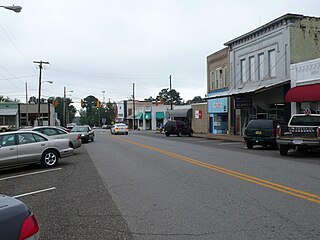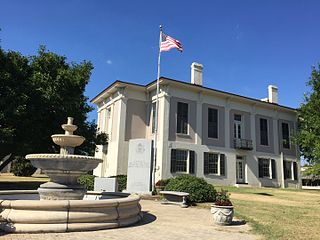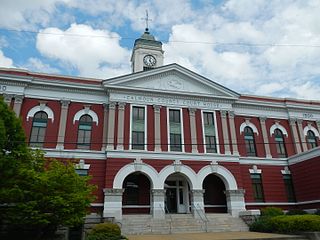
The Fifteenth Amendment to the United States Constitution prohibits the federal government and each state from denying a citizen the right to vote based on that citizen's "race, color, or previous condition of servitude". It was ratified on February 3, 1870, as the third and last of the Reconstruction Amendments.

The Reconstruction era was the period from 1863 to 1877 in American history. It was a significant chapter in the history of American civil rights.

The first African Americans to serve in the United States Congress were Republicans elected during the Reconstruction Era. After slaves were emancipated and granted citizenship rights, freedmen gained political representation in the Southern United States for the first time. White Democrats regained political power in state legislatures across the South and worked to restore white supremacy. By the presidential election of 1876, only three state legislatures were not controlled by white Democrats. The Compromise of 1877 completed the period of Redemption by white Democratic Southerners, with the withdrawal of federal troops from the South. State legislatures began to pass Jim Crow laws to establish racial segregation and restrict labor rights, movement and organizing by blacks. They passed some laws to restrict voter registration, aimed at suppressing the black vote.
United States v. Cruikshank, 92 U.S. 542 (1876), was an important United States Supreme Court decision in United States constitutional law, one of the earliest to deal with the application of the Bill of Rights to state governments following the adoption of the Fourteenth Amendment.
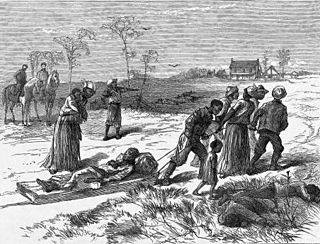
The Colfax massacre, or Colfax riot as the events are termed on the 1950 state historic marker, occurred on Easter Sunday, April 13, 1873, in Colfax, Louisiana, the seat of Grant Parish, when approximately 150 black men were murdered by white Southerners.
In United States history, the Redeemers were a political coalition in the Southern United States during the Reconstruction Era that followed the Civil War. Redeemers were the Southern wing of the Bourbon Democrats, the conservative, pro-business faction in the Democratic Party. They sought to regain their political power and enforce white supremacy. Their policy of Redemption was intended to oust the Radical Republicans, a coalition of freedmen, "carpetbaggers", and "scalawags". They generally were led by the rich former planters, businessmen, and professionals, and they dominated Southern politics in most areas from the 1870s to 1910.
The Mississippi Plan of 1875 was developed by conservative white Democrats as part of the white insurgency during the Reconstruction Era in the Southern United States. It was devised by the Democratic Party in that state to overthrow the Republican Party in Mississippi by means of organized threats of violence and suppression or purchase of the black vote. Democrats wanted to regain political control of the legislature and governor's office. Their success in doing so led to similar plans being adopted by white Democrats in South Carolina and other majority-black states.

The Reconstruction Amendments are the Thirteenth, Fourteenth, and Fifteenth amendments to the United States Constitution, adopted between 1865 and 1870, the five years immediately following the Civil War. The last time the Constitution had been amended was with the Twelfth Amendment more than 60 years earlier in 1804. The Reconstruction amendments were important in implementing the Reconstruction of the American South after the war. Their proponents saw them as transforming the United States from a country that was "half slave and half free" to one in which the constitutionally guaranteed "blessings of liberty" would be extended to the entire populace, including the former slaves and their descendants.

The 1876 South Carolina gubernatorial election was held on November 7, 1876 to select the governor of the state of South Carolina. The election campaign was a referendum on the Radical Republican-led state government and their Reconstruction policies. Opponents disputed the challenger Wade Hampton III's victory, gained by a margin of little more than 1100 votes statewide. But he took office in April 1877, after President Hayes withdrew federal troops as a result of a national Democratic compromise, and the incumbent Daniel Henry Chamberlain left the state.
The Red Shirts or Redshirts of the Southern United States were white supremacist paramilitary groups that were active in the late 19th century in the last years of, and after the end of, the Reconstruction era of the United States. Red Shirt groups originated in Mississippi in 1875, when Democratic Party private terror units adopted red shirts to make themselves more visible and threatening to Southern Republicans, both whites and freedmen. Similar groups in the Carolinas also adopted red shirts.
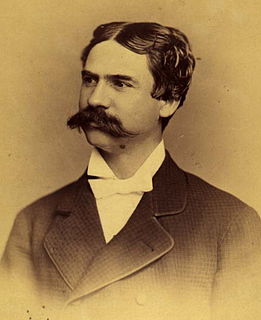
Henry Clay Warmoth was an American attorney, Civil War officer in the Union Army, who was elected governor and state representative of Louisiana. A Republican, he was 26 years old when elected as 23rd Governor of Louisiana, one of the youngest governors elected in United States history. He served during the early Reconstruction Era, from 1868 to 1872.
Disenfranchisement after the Reconstruction Era in the United States of America was based on a series of laws, new constitutions, and practices in the South that were deliberately used to prevent black citizens from registering to vote and voting. These measures were enacted by the former Confederate states at the turn of the 20th century, and by Oklahoma when it gained statehood in 1907, although not by the former border slave states. Their actions were designed to frustrate the objective of the Fifteenth Amendment to the United States Constitution, ratified in 1870, which sought to protect the suffrage of freedmen after the American Civil War.
The Election Riot of 1874, or Coup of 1874, took place on election day, November 3, 1874, near Eufaula, Alabama in Barbour County. Freedmen comprised a majority of the population and had been electing Republican candidates to office. Members of an Alabama chapter of the White League, a paramilitary group supporting the Democratic Party's drive to regain conservative political power in the county and state, attacked black Republicans at the polls.

The Meridian race riot of 1871 was a race riot in Meridian, Mississippi in March 1871. It followed the arrest of freedmen accused of inciting riot in a downtown fire, and blacks' organizing for self-defense. Although the local Ku Klux Klan (KKK) chapter had attacked freedmen since the end of the Civil War, generally without punishment, the first local arrest under the 1870 act to suppress the Klan was of a freedman. This angered the black community. During the trial of black leaders, the presiding judge was shot in the courtroom, and a gunfight erupted that killed several people. In the ensuing mob violence, whites killed as many as 30 blacks over the next few days. Whites drove the Republican mayor from office, and no person was charged or tried in the freedmen's deaths.

Elections in Alabama are authorized under the Alabama State Constitution, which establishes elections for the state level officers, cabinet, and legislature, and the election of county-level officers, including members of school boards.

The 1870 Alabama gubernatorial election took place on November 8, 1870 in order to elect the Governor of Alabama. Incumbent Republican William Hugh Smith was narrowly defeated by Democrat Robert B. Lindsay.
